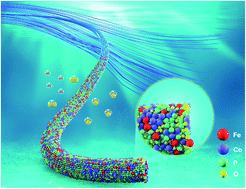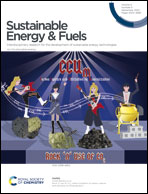Iron-doped cobalt phosphate 1D amorphous ultrathin nanowires as a highly efficient electrocatalyst for water oxidation†
Abstract
Rationally designing active and stable amorphous catalysts with ultrathin nanostructures for the oxygen evolution reaction (OER) is highly desirable, but still remains a substantial challenge. Herein, we report the facile solvothermal synthesis of amorphous Fe-doped Co3(PO4)2 (Am Fe–Co3(PO4)2) ultrathin nanowires with diameters of about 2.0 nm as an efficient electrocatalyst for the OER. The amorphous nature and ultrathin nanowire structure can increase the electrochemically active surface area for exposing more catalytically active sites; meanwhile, Fe incorporation contributes to enhancing intrinsic catalytic activity and electrical conductivity. As a result, Am Fe–Co3(PO4)2 ultrathin nanowires with structural and compositional benefits exhibit remarkable OER electrocatalytic performance, with a low overpotential of 245 mV at 10 mA cm−2 in 1.0 M KOH, and a small Tafel slope of 42 mV dec−1, as well as robust durability. This work provides a novel strategy to synthesize other doped amorphous ultrathin nanomaterials with a well-defined structure for developing highly efficient OER catalysts.



 Please wait while we load your content...
Please wait while we load your content...